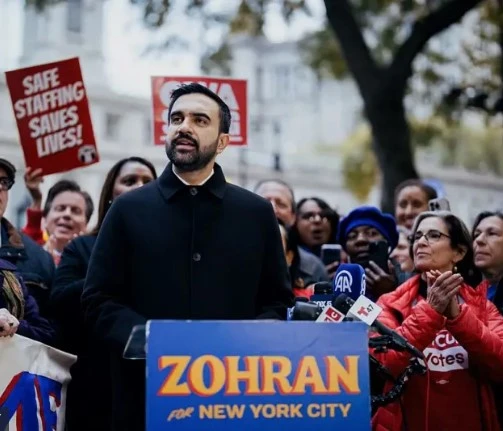By Raju Prabath Lankaloka
One hundred and five years ago, on October 24 and 25 in 1917 according to the Julian calendar used by Imperial Russia (on November 6 and 7 according to Gregorian Calendar), the Russian working class seized power. Witnessing those earth-shattering events of October, American journalist John Reed wrote as below.
“No matter what one thinks of Bolshevism, it is undeniable that the Russian Revolution is one of the greatest events in human history, and the rule of the Bolsheviki a phenomenon of worldwide importance.”
Yet, the apologists of capitalism try to comfort themselves with the thought that the collapse of Stalinist states and USSR signified the demise of socialism. But what really failed in USSR was not socialism, but a caricature of socialism.
Therefore, it is important that all those who are fighting for a better world today should make a serious study of the lessons of the Bolshevik Revolution of 1917. In order to aid this task, we have decided to publish this article written by Alan Woods of International Marxist Tendency in three parts. This is the first part of that series
………………………………………………………………………………………………………………………………………………………….
The meaning of October Revolution
105 years ago this month, an event took place which altered the entire course of human history. For the first time – if we exclude the brief but glorious episode of the Paris Commune – the working people took power into their own hands and began the gigantic task of the socialist re-construction of society.
One of the greatest books of the twentieth century is Leon Trotsky’s History of the Russian Revolution. This monumental study of the event of 1917 has never been equalled. In that book he has stated that: “The October revolution laid the foundation of a new culture, taking everybody into consideration, and for that very reason immediately acquiring international significance. Even supposing for a moment that owing to unfavourable circumstances and hostile blows the Soviet regime should be temporarily overthrown, the inexpungable imprint of the October revolution would nevertheless remain upon the whole future development of mankind.”
However, in order to justify the capitalist system, it is necessary to blacken the name of socialism, and especially of scientific socialism, as expressed in the ideas of Marx, Engels, Lenin and Trotsky. Above all, it is necessary to show that revolution is a bad thing, that it represents a horrible deviation from the “norms” of peaceful social evolution, which inevitably ends in disaster.
Even during the 200th anniversary of the French revolution, despite the fact that this was a bourgeois revolution, despite the fact that it occurred two centuries ago, nevertheless, the ruling class in France and elsewhere could not refrain from denigrating the memory of 1789-93. Even such a distant historical event was an uncomfortable reminder to the rich and powerful of what happens when a given socio-economic system reaches its limits.
Yet revolutions happen, and not by accident. A revolution becomes inevitable when a particular form of society enters into conflict with the development of the productive forces, which form the basis of all human progress.
In an effort to discredit the October Revolution, the ruling class, through the agency of its hired hacks in the Universities, has assiduously cultivated the myth that the Bolshevik Revolution was only a “coup d’etat” pulled off by Lenin and a handful of conspirators.
Intervention of Masses
In reality, as Trotsky explains, the essence of a revolution is the direct intervention of the masses in the life of society and politics. In “normal” periods, the majority of people are content to leave the running of society in the hands of the “experts” – the parliamentarians, councillors, lawyers, journalists, trade union officials, university professors, and the rest of them.
Over a period, which may be a protracted period of years or even decades, society may acquire the appearance of a certain “equilibrium.” This is particularly true in a prolonged period of capitalist economic upswing, like that which lasted for nearly four decades after the end of World War Two.
In such periods, the ideas of Marxism are not readily accepted or understood, because they appear to fly in the face of “the facts.” On the contrary, the illusions of the reformists Labour leaders of a slow, gradual, evolutionary change – “today better than yesterday, and tomorrow better than today” – achieve a widespread audience.
However, beneath the apparently calm surface, powerful currents are building up. There is a gradual accumulation of discontent and frustration in the masses, and an increasing malaise among the middle layers of society. This is particularly felt by the intellectuals and students, who are a sensitive barometer reflecting the changing moods of society.
In a marvellously graphic phrase, Trotsky refers to the “molecular process of revolution”, which goes on in uninterrupted fashion in the minds of the workers. However, since this process is a gradual one which does not affect the general political physiognomy of society, it goes unnoticed by everyone – except the Marxists.
In just the same way, the ground appears to be solid and firm under our feet (“as steady as a rock,” as the saying goes). But geology teaches that rocks are by no means steady, and that the ground is constantly shifting beneath our feet. The continents are on the march, and in a state of perpetual “warfare,” one colliding with another. Since geological change is not measured by years or even centuries, but aeons, the continental shifts remain unnoticed except for specialists. But fault-lines build up, subject to unimaginable pressures, which eventually erupt in earthquakes.
Wars and Revolutions
Similar fault-lines exist in the best-ordered societies. The sudden eruption of wars and revolutions obey approximately the same laws as earthquakes, and are just as inevitable. The moment inevitably arrives when the mass of people decide that “things can’t go on like this any longer.” The break occurs when the majority move to take their lives and destiny into their own hands. This, and nothing else, is the inner meaning of a revolution.
For the well-fed academic, a revolution is an aberration, a “freak,” a deviation from the norm. Society temporarily goes “mad,” until eventually “order” is restored. For such a psychology, the most satisfactory mental image of a revolution is that of a blind herd which has suddenly panicked, or, better still, a conspiracy hatched by demagogues.
In reality, the psychological changes which occur with extreme abruptness in any revolution, are not accidental, but are rooted in the whole previous period.
The human mind, in general, is not revolutionary, but conservative. As long as conditions are generally acceptable, people tend to accept the existing state of affairs within society. Consciousness tends to lag far behind the changes which occur in the objective world of the economy and society.
Only in the last resort, when there is no alternative, do the majority opt for a decisive break with the existing order. Long before this, they will try by every means to adapt, to compromise, to seek the imagined “line of least resistance.” That is the secret of the appeal of reformist politics, especially in a period of capitalist upswing, but not exclusively.
The October Revolution was the product of the entire preceding period. Before finally opting for the Bolsheviks, the Russian workers and peasants had already passed through the experience of two revolutions (1905 and February 1917) and two wars (1904-5 and 1914-17).
Tsarist Russia, which was numbered as one of the principal imperialist states with a powerful army, was nevertheless an economically backward capitalist power. By the law of combined and uneven development, large-scale industry was established in a handful of centres (mainly Moscow, St. Petersburg, the Western region, Urals and Donbass) as a result of Western investment. However, the vast majority of the population were peasants, sunk in conditions of almost medieval backwardness. In many respects, the social composition of Russian tsarism was similar to that of many Third World countries today.
Despite its numerical smallness, the Russian working class set its stamp on events very early on. In the stormy strike wave of the 1890’s, it announced its existence to the world. From that moment, the “labour question” was to occupy a central position in Russian politics.
The stormy growth of industry in the early years of 20th century led to a rapid growth of the working class. Unlike Britain, where capitalism experienced a slow, gradual, organic growth for 200 years, the development of capitalism in Russia was telescoped into a couple of decades.
As a result, Russian industry did not have to pass through the phase of handicrafts, small cottage industry, through manufacture to large-scale enterprises. Huge factories were established with the most modern techniques imported from Britain, Germany and the USA. Along with the most modern technology imported from the West, came the most modern and advanced ideas of socialism.
From the 1890’s onwards, Marxism succeeded in displacing the old terrorist and utopian socialist trend of Narodnism as the dominant tendency in the workers’ movement.
Narodniks
The more sophisticated critics of Bolshevism try to draw a distinction between civilised “Western” Marxism, and crude, barbarous Leninism, a product, allegedly, of Russian backwardness.
As a matter of fact, there is little or nothing of a specifically Russian character about the ideas of Lenin, who spent all his life tirelessly combating the Narodniks for their “Russian road to socialism.”
Both Lenin and Trotsky dedicated their lives to the defence of socialist internationalism. Their ideas can no more be considered “Russian” than Marx’s ideas be portrayed as “German.” Lenin and Trotsky developed and expanded Marxism, but defended the fundamental ideas and principles worked out by Marx and Engels from 1848 on.
The first great test for the Russian Marxists came in 1905.
The deep social crisis was brought to a head by the Russo-Japanese war, which ended in a military disaster for tsarism. On the ninth of January 1905, the working people of St. Petersburg assembled, with their families, for a peaceful demonstration on the square of the Winter palace. Their aim was to present a petition to the tsar – the “little father.”
The bulk of these workers, most of whom had only recently come from the villages, were not only religious, but monarchists. The Marxists (or Social Democrats, as they were then called) had very small forces, and were split between Bolsheviks and Mensheviks. When they tried to distribute leaflets denouncing the monarchy, in several places the workers tore up the leaflets and even beat them up.
Yet within nine months the same workers had organised a revolutionary general strike and a soviet, and by the end of the year, the workers of Moscow had risen in armed insurrection.
In all the urban centres the Social Democrats become transformed into the decisive force. The 1905 revolution was defeated in the main because the movement in the countryside only got underway after the workers in the towns had suffered a defeat.
For a number of years (1907-11), Russia was plunged into the dark night of reaction. Yet by 1911-12, there was a new beginning, characterised by a massive strike wave (partly reflecting an upturn in the economy), which, beginning with economic demands, rapidly took on a political character.
During this period the Bolsheviks gained a decisive majority in the organised working class. They broke with the opportunist Menshevik wing in 1912 and set up the Bolshevik Party.
It should be remembered, however, that the Bolsheviks and Mensheviks had been tendencies in the existing traditional mass party of the workers – the RSDLP (Russian Social Democratic Labour Party), and even after 1912, the Bolsheviks still called themselves the RSDLP (B).
First World War
On the eve of the First World War, Russia stood once more on the brink of revolution. It is possible that the Bolsheviks could have come to power then, but the situation was cut across by the outbreak of hostilities in August 1914. During the war, the Bolshevik party was decimated by arrests and exile. The youth, which was the party’s main avenue of recruitment, was conscripted into the army, where the worker element was scattered in a sea of backward peasant soldiers.
In exile, Lenin was in contact with maybe a couple of dozen collaborators. In 1915, at the Conference of socialist internationalists in Zimmerwald, Lenin joked that you could put all the internationalists in the world into two stage-coaches.
At a meeting of Swiss young socialists in January 1917, Lenin said that he probably would not live to see the socialist revolution. Within a few weeks, the tsar had been overthrown, and by the end of the year, Lenin was at the head of the first workers’ government in the world.
How to explain such a dramatic turn of events? Vulgar historians explain revolution as the product of extreme misery. That is one-sided and false. If that were true, as Trotsky explains, the masses in a country like India would always be in revolt. The victory of reaction in the period of 1907-11 was facilitated by the economic crisis which, coming after a political defeat, temporarily stunned and disoriented the workers. As Trotsky predicted, it took an economic revival (1911-12) to allow the movement to recover.
Booms and Slumps
In reality, neither booms nor slumps in and of themselves cause revolutions. But it is the rapid successions of boom and slump, the interruption of the “normal” pattern of existence, which provokes general uncertainty and instability, and causes people to question the existing state of things. Even more profound are the shocks caused by wars, which turn the world upside down, uproot millions and compel men and women to shed their illusions and finally stand face to face with reality.
The February revolution was a concrete expression of the fact that the old regime had reached an impasse. As in 1904-5, the sledge-hammer of military defeat served to expose the inner rottenness of tsarism.
Beginning even during the war, the strike movement in Petrograd assumed sweeping proportions at the start of 1917. The mood of discontent emanating from the industrial centres found an echo in the ranks of the army, suffering from defeat and exhaustion. The crisis of the regime anticipated the movement of the masses.
Every revolution begins, not at the bottom, but at the top. Its first manifestation is a series of crises and splits in the ruling class, which feels itself to be in a blind alley, and unable to continue to rule in the old way.
Trotsky expresses it in the following sense: “A revolution breaks out when all the antagonisms of a society have reached their highest tension. But this makes the situation unbearable even for the classes of the old society – that is, those who are doomed to break up.”
The smell of corruption and scandal always hangs around a regime which has outlived itself. The present-day epidemic of political and financial scandals in Britain, Japan, the USA, Italy, are no more an accident than the Rasputin regime at the court of “Nicholas the Bloody,” or the “Pompadour factor” of the Ancient Regime in France.
![]()




